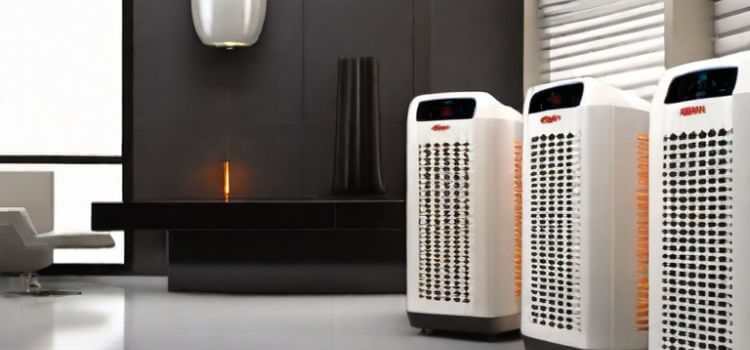As an Amazon Associate, I earn from qualifying purchases.
Air purifiers have become essential appliances in many households, promising cleaner and healthier indoor air. However, there are concerns regarding their impact on room temperature. In this article, we’ll explore whether air purifiers make rooms colder and how to address this issue.

Understanding How Air Purifiers Work
Air purifiers take in air from the surrounding area and run it through filters to capture airborne particles, dust, pollen, and pet dander. By eliminating dangerous contaminants, this filtration process helps enhance indoor air quality.
Filtering Mechanism
Most air purifiers use HEPA (High-Efficiency Particulate Air) or activated carbon filters to effectively capture airborne particles. Activated carbon filters are more successful in eliminating gasses and odors, even though HEPA filters can capture particles as small as 0.3 microns.
Impact on Room Temperature
One common concern is whether the operation of air purifiers affects room temperature. Theoretically, as air passes through the purifier and encounters resistance from the filters, temperature might decrease slightly. However, the extent of this cooling effect varies depending on several factors.
Common Misconceptions about Air Purifiers
Before addressing whether air purifiers make rooms cold, dispelling some common misconceptions surrounding these devices is essential.
Do Air Purifiers Make Rooms Cold?
The answer to this question is more complex than yes or no. While air purifiers may have a slight cooling effect, it’s usually negligible and hardly noticeable. Several factors influence whether an air purifier will significantly lower the room temperature.
Factors Influencing Temperature
- Room Size: In larger rooms, the cooling effect of an air purifier is likely to be less noticeable compared to smaller spaces.
- Airflow: The rate at which air circulates in the room affects how quickly any temperature changes occur.
- Type of Air Purifier: Different air purifiers may impact room temperature differently. For instance, some models with built-in fans may produce a more noticeable cooling effect than others.
Thermal Dynamics of Air Purifiers
Air purifiers draw in air, filter it, and then release it back into the room. During this process, there might be a minor drop in temperature due to the interaction between the air and the filters. However, this temperature reduction is typically insignificant and unlikely to make a room feel noticeably colder.
Strategies to Prevent Cooling Effect
While air purifiers may have a minimal impact on room temperature, there are several strategies you can employ to mitigate any cooling effects:
Placement of Air Purifiers
Position the air purifier strategically in the room to ensure proper airflow without creating drafts. Avoid placing it directly in front of windows or doors where cold air might enter.
Adjusting Fan Speeds
Many air purifiers have fan speeds that can be changed. By reducing the fan speed, you can minimize any cooling effect and decrease airflow while still maintaining efficient air filtering.
Utilizing Multi-functional Units
Consider investing in air purifiers that serve other purposes, such as space heaters or humidifiers. These multi-functional units can help offset any cooling effect by providing additional warmth or moisture to the room.
Benefits of Using Air Purifiers
Despite the potential for a slight cooling effect, the benefits of using air purifiers far outweigh any concerns about room temperature. Some of the advantages include:
- Improved Indoor Air Quality
- Allergy Relief
- Odor Removal
- Reduction of Airborne Pollutants
- Healthier Living Environment
Conclusion
While air purifiers may have a minimal impact on room temperature, their benefits in improving indoor air quality and promoting better health far outweigh any concerns about a slight cooling effect. By understanding how air purifiers work and implementing strategies to mitigate any potential cooling, you can enjoy clean and fresh air without compromising comfort.
FAQs
Yes, electricity usage for air purifiers varies according to the unit’s size, speed settings, and filter performance, among other factors. Generally, newer models are designed to be energy-efficient, so they shouldn’t significantly impact your electricity bill.
Yes, you can operate your air purifier constantly, particularly if you have health conditions like allergies or respiratory problems related to poor air quality. However, to maintain the best performance, it is imperative to adhere to the manufacturer’s instructions for usage and filter replacement.
Some air purifiers, particularly those using electrostatic precipitators or ozone generators, may produce ozone as a byproduct. It’s essential to select air purifiers certified as ozone-free by respectable organizations like the California Air Resources Board (CARB) because ozone can damage health, especially in high amounts.
The air pollution in your location, the manufacturer’s recommendations, and how frequently you use the purifier affect how often you should replace the filters. While carbon filters can last up to six months, HEPA filters typically need to be changed every six to twelve months.
Yes, cooking smoke, smells, and other airborne particles can be successfully eliminated by air purifiers with activated carbon filters installed. It is imperative to select a type with enough airflow and filter capacity to deal with the particular smells in your house.
As an Amazon Associate, I earn from qualifying purchases.
Leave a Reply